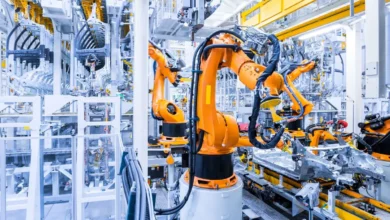
The fiber laser cutting machine is a technological innovation in the field of metalworking and manufacturing. Precision and accuracy in cutting and shaping metal sheets are achieved with the aid of these machine tools.
With the expansion of Industrial laser applications, the competitive advantage of fibre laser cutting systems has gained prominence in the market due to their cost-effectiveness and improved productivity.
View Top Fiber Laser Cutting Machine manufacturers and suppliers in China – UDMachine details to get into the details.
What is a Fiber Laser Cutting Machine?
Technology Behind Fiber Laser Cutting
A fiber laser cutting machine combines fiber lasers, which produce light through stimulated emission within optical fibers. The process employs high-quality glass fibers to develop a concentrated light beam. Therefore, fiber lasers provide superior coherent light sources, which can easily cut various metals accurately.
Fiber lasers are more efficient and offer less operating energy loss compared to traditional laser sources. These advances expand the use of such machines across different manufacturing sectors and place them as fundamental tools in modern metal fabrication.
How Fiber Laser Cutters Work
These cutters use a high-intensity laser beam to concentrate on the workpiece, which melts, burns, or vaporizes the metal. As the laser beam’s optics focus on the material’s surface, the machine can rapidly heat and cut the metal.
With the sophisticated use of new cutting heads and CNC technology, the machine is now capable of moving with accuracy, executing minute details that would otherwise be a lengthy process when carried out manually.
Since the operators are not required to be physically present to control the machines, they can now use the CNC system to program various patterns and forms, which provides the overall manufacturing facility with increased speed, flexibility, and diversity.
Use of Fiber Laser Cutting Technology in Different Industries
The increased use of fiber laser cutting technology is attributed to its applications in the automotive, aerospace, electronics, and metal fabrication industries. In automotive engineering, fiber laser cutting is precise and beneficial for the production of high-precision parts.
The aerospace sector has also been effectively utilizing fiber lasers to cut lightweight materials due to their ability to make complex geometry cuts, which are crucial in aircraft construction.
Furthermore, the electronics industry also utilizes fiber lasers in board and component production, as well as soldering, due to their accuracy and speed. As pointed out, fiber laser cutters provide increased flexibility in operations and processes in manufacturing companies.
Advantages of Using a Fiber Laser Cutting Machine
Why Choose Fiber Laser Cutting Over Traditional Methods?
Transitions from conventional cutting techniques to fiber laser cutting offer numerous advantages. To begin with, laser cutting makes the cutting process more efficient by reducing the time required and increasing throughput.
Compared to other cutting technologies, laser cutting is more rapid while offering higher-quality cuts, which require minimal post-processing effort. It enables a significant reduction in labor costs.
Moreover, in contrast to the traditional cutting machines, fiber lasers are less expensive to operate, consume less energy, and require less total maintenance. Increased longevity and operating life in maintenance fiber lasers translate to companies needing to replace equipment significantly less, rendering this approach a sound investment.
Precision and Efficiency in Metal Cutting
In the case of fiber laser cutting machines, their unmatched precision makes them different from other devices and tools. Thicker materials can be converted into detailed designs and finer cuts with reduced kerf because of the condensed beam, which has the ability to generate detail.
Being precise is crucial laser applications wherein the end product must be able to function in specific parameters. Additionally, fiber laser cutters can accurately process a wide range of metals, from thin sheets to thicker plates, ensuring that production needs are met while maintaining high standards.
Cost-Effectiveness of Fiber Laser Cutters in Manufacturing
In the context of manufacturing, cost-effectiveness is always a crucial consideration. It appears that laser cutting machines may be initially expensive, but they offer significant cost savings in the long run.
The decrease in energy consumption, maintenance expenses, and the ability to perform multiple cutting operations with minimal changes in tooling all guarantee a positive return on investment.
It also enhances production efficiency, enabling companies to act based on market demand without incurring significant expenses, further demonstrating that fiber laser cutting is an economically viable option for sustainable growth in the manufacturing sector.
Choosing the Right Fiber Laser Cutter Model for Your Shop
Factors to Consider When Selecting a Fiber Laser Cutting Machine
There are several key things to consider when selecting a fiber laser cutting machine for your shop. The details of your production workflow, including the materials you will be cutting and the level of design complexity, will significantly influence the model you choose.
Potential customers should also consider the power features included, as higher-wattage machines offer greater cutting speeds and capabilities, particularly when working with heavier materials.
Of equal relevance is the machine’s capability to integrate with other systems and support applications, ensuring that the new equipment builds upon and does not interfere with existing operations.
Evaluating Different Models and Features
To make a comparison of these options, we need to discuss features such as cutting space, material thickness, and laser optics. Moreover, the availability of advanced features like automated loading and unloading systems can also prove to be influential.
Future buyers must make sure that the models chosen will not only fulfil current production requirements but also contribute to long-term growth aspirations.
The Importance of Power and Performance in Fiber Lasers
More powerful machines cut material faster and with higher material versatility, making production more flexible. These two factors are optimal if optimized for the task at hand; otherwise, energy as well as money will be lost.
Opting for a suitable fibre laser cutter enhances efficiency. It maintains the production of high-quality outcomes, which translates to good business in terms of increased output and overall customer satisfaction. Operating and Maintaining Your Fiber Laser Cutting Machine
Operating and Maintaining Your Fiber Laser Cutting Machine
Best Practices for Operating a Laser Cutter Safely
Operators should be trained in the proper usage of these machines and adhere to safety regulations to avoid accidents. Some recommended safety practices include the use of protective eyewear and maintaining a clean work area.
Operators also need to regularly inspect the laser cutting machine to ensure that safety features, such as the emergency shut-off mechanisms, are in working condition to prevent unintended activations during ongoing processes.
Regular Maintenance Tips for Longevity
Daily routine maintenance operations should include cleaning the optics and lenses, as failure to do so will allow soil to settle and negatively impact cutting accuracy. Preventive maintenance through planned coolant system inspections ensures aged parts are replaced, which can avert unexpected downtime.
Additionally, operators should monitor maintenance operations closely, as it may be the difference between resolving issues and planning for effective equipment upgrades.
Challenges and Solutions Approaches
Operational issues can occur with advanced machinery such as fiber laser cutting machines. These issues primarily result from unstable cutting quality caused by a misaligned machine, degraded optics, or improper settings.
Each machine part needs to be analyzed by the operators and alignment, calibration, and cutting parameters need to be checked to correct these issues. Adopting a step-by-step approach will not only resolve the problem at hand promptly, but also enhance the reliability and efficiency of industrial laser cutters in the long run.
Future Trends in Fiber Laser Cutting Technology
Innovations on the Horizon for Fiber Laser Cutting Machines
These developments can be achieved with the assistance of new technology such as artificial intelligence and machine learning. These technologies continue with real time adaptive cutting that alters parameters in the course of cutting to enhance accuracy and efficiency. Future gains may also arise from laser source technology, such as more plasma-like lasers and the ability to process a broader range of materials.
The Impact of Automation on Laser Cutting in Manufacturing
Automation will also enhance cutting by using robots for material transport, and computer-automated nesting software, which utilizes the materials effectively, hence reducing waste. Implementation of automatic systems will assist companies in attaining their ever-growing operating efficiency, and automated fiber laser cutting systems are sure to be the standard in the industry.
How Fiber Lasers Are Shaping the Future of Fabrication
The effect of fiber lasers on the fabrication future is astounding and still expanding. The machines aid in fulfilling the increased demand for customization in manufacturing since they need varying and more intricate cutting possibilities.
Due to their accuracy and speed, as well as their ability to work with various materials, companies can adapt to changing market requirements. Combined with automation and advances in AI, this versatility renders fiber laser cutters indispensable in future and contemporary manufacturing technology. It ensures that they will remain crucial in metal fabrication for decades to come.

















